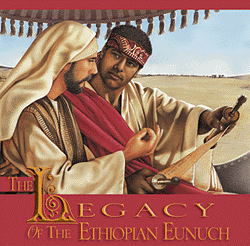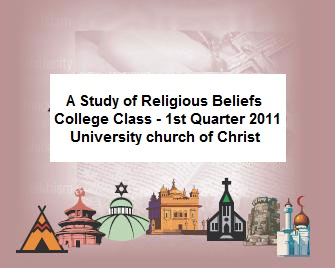Home | About Us | Directions | Bulletins | Sermons & Audio | Cross Of Christ Studies | Classes | Student and Parent Resource Page | Dangers Facing the "Non-Traditional"
Eternal Punishment or Annihilation?
by Mark Mayberry
|
Those who preach the whole counsel of God, must not only emphasize divine love, but also divine wrath. The splendor of heaven should be proclaimed, as well as the repugnance of hell. The horrors of eternal punishment must be clearly communicated, so that we will realize the urgency of obeying God. Many would deny the reality of hell. Materialists, such as the Jehovah's Witnesses, reject the biblical doctrine of eternal punishment. They claim that hell is nothing more than the grave. Notice the following quotation from the Watch-tower Society literature: "The doctrine of a burning hell where the wicked are tortured eternally after death cannot be true, mainly for four reasons: (1) because it is wholly unscriptural; (2) because it is unreasonable; (3) because it is contrary to God's love; and (4) because it is repugnant to justice."' Is the concept of hell contrary to God's love? Remembering that God's ways are infinitely superior to ours, let us not force our thinking on him (Isa. 55:8-9; Jer. 10:23). To say that eternal punishment is incompatible with the love of God is to play God ourselves. God is love, but he is also just. If there is a paradise for the righteous, there must also be a punishment for the wicked. This is guaranteed by the justice of God. Hell reveals the terribleness of sin! Jesus taught that sin will lead to eternal punishment (Matt. 10:28). The inspired apostles also emphasized the same truth (2 Thess. 1:7-9). Those who deny the reality of hell reject the word of God! There are three distinct Greek words which are translated "hell" in the KJV. Recognizing the different meanings and usage of these terms will eliminate the confusion that exists on this subject. As we shall see, the concept of a place of suffering and punishment beyond the grave is clearly taught in the Bible. Sheol The Old Testament word for "hell" is sheol. This Hebrew word occurs 64 times. In the KJV, it is translated "grave" 31 times, "hell" 30 times, and "pit" 3 times. The NASV translates all of these passages as "Sheol." The word is used in two senses: First, it refers to the state of death, the grave, the final resting place of all men. Second, it also describes the realm of the dead, the place of conscious existence after death.' Gesenius defines this word as "a subterranean place, full of thick darkness (Job 10:21-22), in which the shades of the dead are gathered together."' Sheol is used with reference to the righteous (Psa. 16:10; 30:3; etc.) and also the wicked (Job 24:19; Psa. 9:17; etc.). While the Old Testament describes the afterlife much less clearly than does the New, it does indicate that there will be punishment for the wicked beyond the grave (Isa. 33:14; 66:24; Dan. 12:2; etc.). Hades The Greek word Hades appears 11 times in the New Testament (Matt. 11:23; 16:18; Lk. 10:15; 16:23; Acts 2:27,31; 1 Cor. 15:55; Rev. 1:18; 6:8; 20:13-14). In the KJV, it is rendered "hell" in every case except in 1 Corinthians 15:55, where it is translated "grave." More recent versions substitute "Hades" for "hell" in these passages, and use the word "hell" as a translation for the Greek word Gehenna (RSV, ASV, NASV, NIV). As the New Testament equivalent of Sheol, its meaning and significance are quite similar. Hades refers to the grave, the underworld, the region of departed spirits, the unseen world of the dead. In ancient Greek literature, this word was originally the proper name of Hades, or Pluto, the god of the lower regions and the under-world. Thayer defines Hades as "the netherworld, the realm of the dead . . . the common receptacle of disembodied spirits." Arndt and Gingrich define this Greek word as "the underworld as the place of the dead."' Hades is the intermediate state where departed souls go to await the resurrection and the judgment. Ac-cording to God's Word, Hades is composed of two realms: Paradise and Torment. While the body of Jesus lay in the tomb, his soul went temporarily to Hades (Acts 2:27,31), or more specifically Paradise (Lk. 23:43). We understand this place to be distinct from heaven because of the statement of Jesus that is recorded in John 20:17. The resurrected Christ said unto Mary, "Touch me not; for I am not yet ascended to my Father... " Hades is a place of bliss for the righteous, but a place of torment for the wicked. In Luke 16:19-31, the rich man died and went to Hades where he was tormented in flame (vv. 23, 25, 28). When Lazarus died, he was carried to Abraham's bosom (v. 23) where he was comforted (v. 25). Notice also that both men continued to have a conscious existence beyond the grave, although neither could cross into the other realm (v. 26). Gehenna This Greek word gehenna appears 12 times in the New Testament and is uniformly translated "hell" (Matt. 5:22,29,30; 10:28; 18:9; 23:15,33; Mk. 9:43,45,47; Lk. 12:5; Jas. 3:6). The word is a transliteration from the Hebrew "Valley of Hinnom." The name is derived from the Hebrew Ge-Hinnom, which refers to a ravine which lay south and east of Jerusalem, spoken of in Scripture as "the valley of the son of Hinnom" (Josh. 15:8; 18:16; etc.). This valley had once been the site of idol worship. During the darkest days of their apostasy, the Israelites had sacrificed their children to the idol Molech in this place (Jer. 32:35). The cries of infants echoed through this valley as they were thrown into the fiery arms of Molech, an idol which had the form of a bull. King Ahaz and Manasseh both engaged in the horrid practice of child sacrifice (2 Chron. 28:3; 33:6). Because of the atrocities committed in the valley of Hinnom, Jeremiah prophesied that the wrath of God would fall there (Jer. 7:28-34). After good king Josiah desecrated and destroyed this idolatrous site, it became a place of abomination (2 Kgs. 23:10-14). The Jews developed such an abhorrence for the place that "they cast into it not only all manner of refuse, but even the dead bodies of animals and of unburied criminals who had been executed."` "Later the valley seems to have been used for burning the corpses of criminals and animals, and indeed refuse of any sort."' Over time the valley of Hinnom became a garbage dump where fires were constantly burning. That the rubbish and refuse of Jerusalem was collected there only helped make the valley of Hinnom synonymous with extreme defilement. In time the place came to symbolize terrible wickedness, filth and rottenness, pain, anguish and loathsomeness. Understandably, the Jews came to believe that the final judgment would occur at that site. Because of the horrible history associated with this valley, its name became a symbol of that place where the wicked after death suffer eternal punishment.' The distinction between Hades and Gehenna is important. The former refers to that intermediate state between death and the resurrection, while the latter refers to that place of eternal punishment. Ultimately, death and Hades shall be cast into the lake of fire, which is the second death. And anyone whose name is not written in the book of life will be cast into the lake of fire (Rev. 20:14-15). Jesus urged his disciples to avoid the fires of Gehenna at all costs (Mk. 9:43-47). Tartarus Tartarus occurs only in 2 Peter 2:4. It is also referred to in Jude 6 though not mentioned by name. It stands for the place of punishment for fallen angels. There are angels that sinned who are "reserved unto judgment." This region is referred to as "pits of darkness" (NASV). According to Greek mythology, the departed spirits of the extremely wicked men were punished in this place. Similar ideas were found in Jewish apocalyptic literature as well. Strong defines Tartarus as "the deepest abyss of Hades.' Arndt & Gingrich say that Tartarus was thought of by the Greeks as "a subterranean place lower than Hades where divine punishment was meted out.'' Thayer says that it is "the name of a subterranean region, doleful and dark, regarded by the ancient Greeks as the abode of the wicked dead, where they suffer punishment for their evil deeds; it answers to Gehenna of the Jews."" Conclusion Christ said, "And these (i.e., the wicked) shall go away into everlasting punishment: but the righteous into life eternal" (Matt. 25:46). However, the Jehovah's Witnesses' New World Translation says, "And these will depart into everlasting cutting-off, but the righteous ones into everlasting life." Words such as "destroy" (Matt. 10:28) and "destruction" (2 Thess. 1:7-9), do not imply "annihilation" as Witnesses claim. Rather, the thought is one of total loss and ruin. Thayer defines these words as "to devote or give over to eternal misery" and "the loss of a life of blessedness after death, future misery."" Those who are lost in hell are cut off from God, with no hope, no joy, no love, no goodness, or blessings of any sort. Hell might be tolerated if it lasted a day, a week or a year. Not so! Hell is eternal. Finite minds can hardly conceive of eternity, and yet hell is a place of everlasting punishment and destruction (Matt. 25:46; 2 Thess. 1:9). The Greek word aionios, which is translated "eternal" or "everlasting," occurs 71 times in the New Testament. It describes both heaven and hell (Matt. 25:46), God the Father (Rom. 16:16), the Holy Spirit (Heb. 9:14), etc. Hell will last just as long as heaven. Hell will endure as long as God endures: Forever and ever! Without doubt, the Bible plainly teaches that there is a place of eternal punishment. Thankfully, we can escape this horrible fate through faithful obedience to Christ. Are you ready to face the judgment? (Heb. 9:27; Rom. 14:12; 2 Cor. 5:10-11) Footnotes 'Let God Be True (The Watchtower Bible & Tract Society), p. 80. 'Vine's Expository Dictionary of Biblical Words (Nashville, TN: Thomas Nelson Publishers, 1985), s.v. "Hell: Sheol" (H7585). 'H.W.F. Gesenius, Gesenius' Hebrew-Chaldee Lexicon to the Old Testament, translated by Samuel P. Tregelles (1847; Apt. Grand Rapids, MI: Baker Book House, 1979), s.v. "sheol'' (H7585). 'Joseph Henry Thayer, Greek-English Lexicon of the New Testament, s.v. "Hades" (686). `William F. Arndt, F. Wilbur Gingrich & Frederick W. Danker, A Greek-English Lexicon of the New Testament, 2nd ed. (Chicago: University of Chicago Press, 1979), s.v. "Hades" (G86). 'Joseph Henry Thayer, Greek-English Lexicon of the New Tesatment, s.v. "Gehenna" (G1067). 'The New Bible Dictionary, s.v. "Hinnom, Valley of." 'Joseph Henry Thayer, Greek-English Lexicon of the New Testament, s.v. "Gehenna" (G1067). `James Strong, Dictionary of the Greek Testament, s.v. "Tartaroo" (G5020). 0William F. Arndt, F. Wilbur Gingrich & Frederick W. Danker, A Greek-English Lexicon of the New Testament, 2nd ed. (Chicago: University of Chicago Press, 1979), s.v. "Tartaroo" (G5020). "Joseph Henry Thayer, Greek-English Lexicon of the New Testament, rev. ed., (Wheaton, IL: Evangel Publishing Co., 1974), s.v. "Tartaroo" (G5020). '"Joseph Henry Thayer, Greek-English Lexicon of the New Testament, s.v. "Apollumi" (G622). Guardian of Truth - April 15, 1993 |
Other Articles
How Long?
A Matter of Choice
Babble in Bible Classes, Piffle and Pablum from Pulpits
Exposing Error









